Cretaceous Period
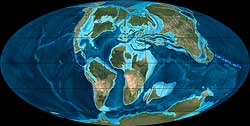
|
|
Global paleogeographic reconstruction of the Earth in the late Cretaceous period 90 million years ago. (Courtesy Dr. Ron Blakey)
|
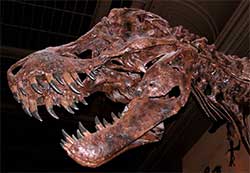
|
|
The Tyrannosaurus rex was the king of dinosaurs during the Cretaceous period.
|
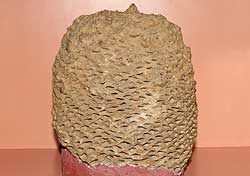
|
|
This Cycadeoidea marylandica is an extinct plant that looks like modern cycads. It
dates to the Cretaceous period, 105 million years ago.
|
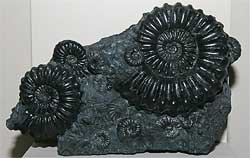
|
| This fossil of an Ammonite (Prolyelliceras cf. peruvianum) dates tothe Early Cretaceous period, 106-100 million years ago. |
| Early Cretaceous | ||
| Berriasian Valanginian Hauterivian Barremian Aptian Albian |
(146 Ma — 140 Ma) (140 Ma — 136 Ma) (136 Ma — 130 Ma) (130 Ma — 125 Ma) (125 Ma — 112 Ma) (112 Ma — 100 Ma) |
|
| Late Cretaceous | ||
| Cenomanian Turonian Coniacian Santonian Campanian Maastrichtian |
(100 Ma — 94 Ma) (94 Ma — 89 Ma) (89 Ma — 86 Ma) (86 Ma — 84 Ma) (84 Ma — 71 Ma) (71 Ma — 65 Ma) |
|
Tectonics
At the beginning of the Cretaceous period the tectonic plates had not separated completely. However, by the end of the period Laurasia had separated into North America and Eurasia and Gondwana had separated into South America, Africa, Antarctica, and Africa. Madagascar and the Indian subcontinent were still connected and would separate after the Cretaceous period, the Indian subcontinent colliding with Eurasia to form the Himalayas.
Environment
The climate remained similar to that of the Jurassic period, warm and humid. However, a few notable changes took place. The environment evolved to the point that flowering plants (angiosperms) began to appear for the first time. This in turn contributed to an increase in insect populations. The landmasses separated into continents that we would recognize today, although in much different positions than those that we currently see. The climate began cooling for much of the period resulting, perhaps, in the changes in flora and plant life. However, as it reached approximately 125 ma the climate began to warm due, in part, to volcanic activity and increased Carbon Dioxide levels in the air.
Cretaceous Life
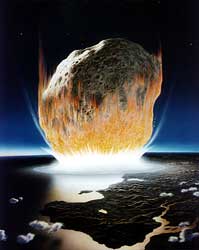
|
| An artist's depiction of the asteroid impact 65 million years ago that many scientists say is the most direct cause of the dinosaurs' disappearance. |
Throughout the Cretaceous period, life diversified and branched out. Dinosaurs remained the dominant species during the Cretaceous period and they expanded, branching into previously less-dominant species like horned dinosaurs. Insects diversified as well as birds. Mammals, although small, spread into many different species.
The Great Extinction
While the cause of the massive extinction brought on at the end of the Cretaceous period is debated, many theories exist. There is evidence of plant decay which would have contributed to the extinction, as all dinosaurs, whether directly or indirectly, depended on plant life. This could have been caused by large asteroid collisions or volcanic eruptions or both. These events would have suspended sunlight, causing plant life to diminish. Other theories include the regression of the sea level, or a combination of many of these possibilities. Most of the species that survived were not as dependent on plant life. Insects survived on other animals and dead organisms and mammals would often feed on insects. This allowed the Mammals to survive until the present day when mammals would replace the dinosaurs as the dominant species.
| Proterozoic eon |
542 Ma - Phanerozoic eon - Present | |||||||||||
|---|---|---|---|---|---|---|---|---|---|---|---|---|
| 542 Ma - Paleozoic era - 251 Ma | 251 Ma - Mesozoic era - 65 Ma | 65 Ma - Cenozoic era - Present | ||||||||||
| Cambrian | Ordovician | Silurian | Devonian | Carboniferous | Permian | Triassic | Jurassic | Cretaceous | Paleogene | Neogene | Quaternary | |